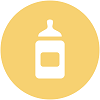When you leave your baby in someone else's care, you rest (or work) easier knowing all needs are tended to. Consider this list a starting point—care providers, both centers and in-home, should be clear about what they require and recommend that you send.
- All the necessary enrollment paperwork, including policies, procedures, schedule, and contact information, to be left with the provider on or before day one. (You should get a copy to keep, too.)
- Diapers (a week's worth)
- A big, refillable container of wipes
- Diaper cream, infant acetaminophen or other necessary medicines (expect to fill out a medication administration form, including specific instructions, first)
- A few pacifiers
- Sunscreen
- Baby thermometer
- Bottles, enough for the day, labeled
- Single-serve formula or breast milk, in separate containers, labeled
- Baby cereal or favorite foods your child eats
- Bibs, for drooling and eating
- A few extra outfits, individually bagged
- Comfort item, such as a favorite stuffed animal or blanket




Sources:
"Daycare centers: Overview." BabyCenter. 2017.
"Home daycare: Overview." BabyCenter. 2017.
"Preparing for Daycare." Childcare Network. 2017.
"Daycare Packing List for Babies." The Spruce. December 30, 2016.
"Information to Share with Your Child Care Provider." Child Care Lounge. 2016.
"Acetaminophen Dosage Table for Fever and Pain." HealthyChildren.org. May 23, 2016.
"Caring for Your Child's Cold or Flu." HealthyChildren.org. April 6, 2016.
"Cleaning Baby Clothes." HealthyChildren.org. November 21, 2015.
Remember: Label everything! If it's something that comes in contact with your baby's skin, use a nontoxic marker or iron-on fabric labels. Grease pencils are great for labeling bottles.
While you're at it, reassess the contents of your diaper bag. Take a look at our checklist to ensure you're prepared on the go.
This content is provided for general information purposes only. It is not intended to be a substitute for medical advice or a guarantee of prevention, improvement, or treatment of specific conditions. Always consult with your healthcare provider about your specific medical questions or concerns.

